At the beginning of 2021, our team visited Westonbirt School in Tetbury, Gloucestershire. The restoration of a wonderfully detailed Victorian mural had been in their plans since 2018, but numerous delays (including COVID-19) had allowed the water damage to develop further. This article tells the story of how our team restored the beautiful ceiling, as well as the history behind the artwork and how to avoid water damage deteriorating painted walls and ceilings.

Types of interior painting decoration
There are several techniques that may have been used to create a mural or ‘fresco’. The most common style is to paint directly onto dry plaster, this is called ‘fresco secco’ and requires the pigment (powdered colour of paint) to be combined with egg (tempera), glue or oil to attach securely to the wall.
 Above: a detail from a Roman wall fresco, 50-40 BCE
Above: a detail from a Roman wall fresco, 50-40 BCE
There is also the lighter technique called ‘buon fresco’ which is a thin pigment that is absorbed into a thinner layer of wet plaster, drying with an infusion into the wall or ceiling – this can last for hundreds of years.
 Above: a selection of fresco paintings by Giovanni Battista Tiepolo and Girolamo Mengozzi, 18th century
Above: a selection of fresco paintings by Giovanni Battista Tiepolo and Girolamo Mengozzi, 18th century
You may also find murals that have been painted directly onto paper, which may face similar risks to artworks found on paper.
 Above: a late 19th century ceiling design
Above: a late 19th century ceiling design
Saving a water damaged mural
When a leaking pipe, roof, wall or ceiling causes water damage to a property, all forms of art may be at risk. However, some may be more in more vulnerable positions than others. Whilst traditional oil paintings, watercolours, and important documents can be removed from an affected area, others are permanently left to face a growing amount of damage or disruption from the central issue or the invasive maintenance repairs which follow.
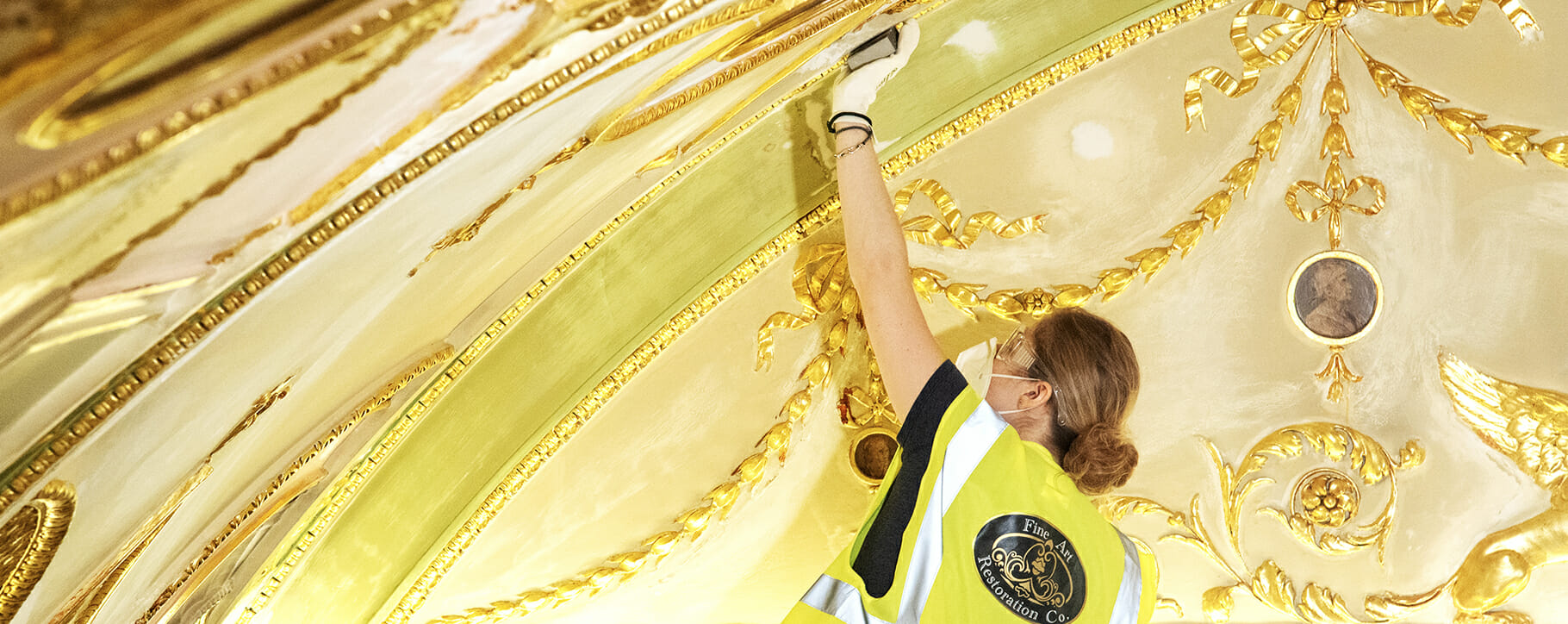
Murals on the walls and ceilings of a home, school or landmark are often unique in their design. The artistic and historic ties of such pieces can be significant to the location or have a wider cultural impact. Their preservation is important to the integrity of the architecture and the wider conservation of the building, especially if it is a listed property.
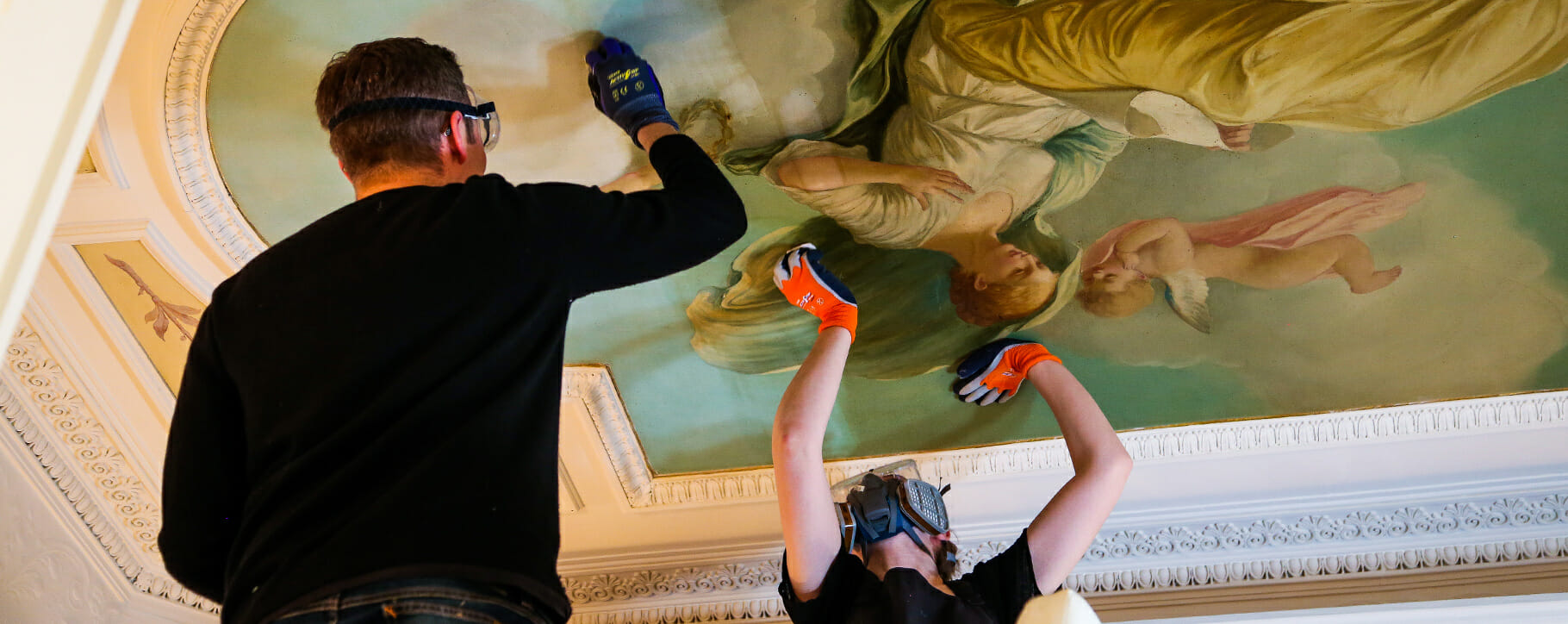
When met with water damage, a mural can physically perish under the strain on the plasterwork, as well as facing discolouration, cracking and textural distortion. If you catch this event in its early stages and act swiftly, the continuation of decay can be avoided and restoration costs will be reduced.

There are several stages of water damage that may be witnessed upon a mural, ranging from light to severe as the wall or ceiling continues to deteriorate.
- The early warning signs of a leak may show up as small areas of discolouration, possibly brown spots or lines which appear in a pattern that you would expect from a light ‘brown water’ stain. You may also notice a wider area of light discolouration, with a brown or sepia tone appearing over an area of the painted wall or ceiling. Depending on the colour tones and clarity of the mural, this may be easier or harder to detect. A vigilant inspection should be carried out on a monthly basis to make this easier to determine. Changes in both colour and texture should be noted during these assessments.
- The second stage of damage may be in the gathering of water beneath the plasterwork, paint, or underlying wallpaper. This may appear more clearly when it is triggered by an affected tap being turned on, a bath or shower being occupied, or during wet weather. However, if there is a small continuous leak occurring, this may have been building up over time. During this stage, there may be a bulge or obvious dripping of water from the affected location, as well as cracking, distorting, or loosening of the paint layer as it comes under stress.
- The third and most severe stage will be the complete deterioration of the mural, starting off as small amounts of the paint or plasterwork falling away, with areas eventually disappearing in their entirety. Wider cracks may also be witnessed, deforming the artwork in texture and making it extremely unstable. If this stage has been reached, it is recommended that any loose pieces are collected ahead of restoration work, as our conservators will always strive to reapply as much of the original painting as possible to allow for historic and artistic integrity.
Contacting our team about restoration work in the earliest possible stage will help to avoid increased loss of the original details and lessen the cost required for its professional conservation.
Westonbirt School’s Oriel Room mural
In November 2018, our team at Fine Art Restoration Company were contacted about a leak that had discoloured areas of an important mural at Westonbirt School in Gloucestershire. The water damage had occurred on the 20ft high ceiling of what is known as the Oriel Room. The 19th-century mural depicts optimistic blue skies, featuring swallows and storks in flight, one of them whimsically holds a viper in its beak as soft white clouds roll above.
Grade I listed Westonbirt House was reconstructed in the early 19th century and again between 1863 and 1870 when the mural would have been commissioned. The various reconstructions of the grand country home were overseen by Robert Stayner Holford, a great patron to the arts and literature, who had inherited wealth that would allow him to create a detailed and artistically centred home. Westonbirt House was reputed to be one of the most expensive houses constructed in the Victorian era.
The Oriel Room is named as such due to the large oriel window, which looks out towards the gardens. Robert Stayner Holford also attended Oriel College at Oxford University, which may have given way to this inspiration. The large windows allow the ceiling to blend with the sky and give the birds further realism.
The mural was designed by the artist Alfred Morgan (1836-1924), whose original design for this specific ceiling is now on display at the Victoria and Albert Museum in London. The theme of the work is representative of the Victorian preoccupation with natural history, as well as sharing a connection with the expansive arboretum on the grounds. It also uses a trompe l’oeil technique (making a flat oil painting appear as three dimensional) to create a visual spectacle above all those who visit it.
The restoration of the Oriel Room mural
The water damage had occurred over a period of time with some areas being more heavily affected than others. Our team of conservators visited Westonbirt House in December 2018 to analyse the extent of the issues which had been raised.
The greatest amount of water damage was to the south-west corner of the piece, however, there was also evidence of this occurring to the opposite corner to a lesser extent. Our conservators saw evidence of issues that are associated with water damage, such as an area of suspected blanching (mould) as well as fly spots (small dark spots of fly excrement) from a possible insect infestation in the past.
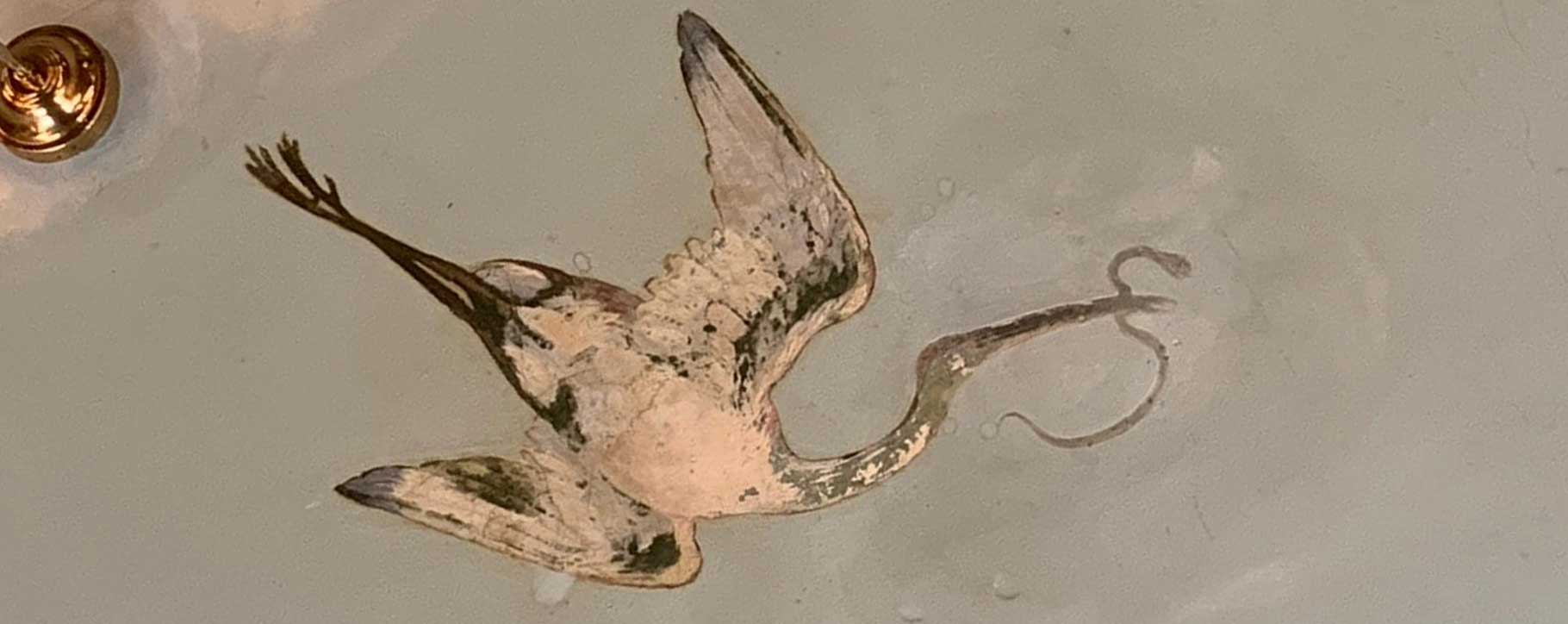
The painting had been visually disturbed by the water damage, as well as being put into a vulnerable condition. Severe discolouration spread in areas of the work, making them appear darkened and yellowing. Secondly, the natural cracks, or craquelure, of the artwork were under stress from the damage, with the paint peeling away from these fragile areas. Further locations of mould were found, as well as historic attempts at restoration which detracted from the original artwork. The past overpainting was most notably in the centre where the stork holds the viper in its beak, the viper had at some point been removed from the work and then later replaced back again.
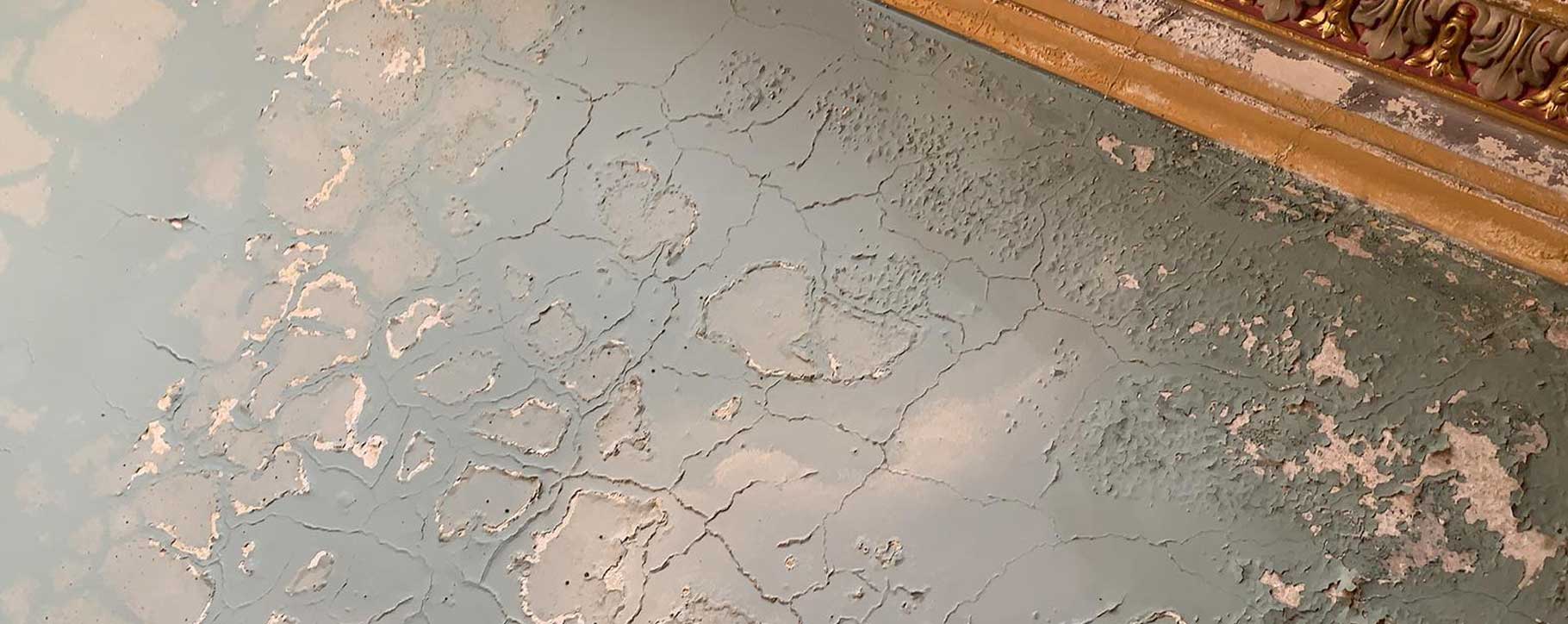
Our team put together a report detailing the condition as well as recommendations for several levels of restoration treatment for consideration. The first was to address only the most recent damage, one for the more historic issues, and the third for a full restoration of the ceiling. The latter would allow for a sensitive and seamless restoration to be taken out, addressing all areas of concern and ensuring the preservation of the piece with a conservation approach.
Whilst the restoration was considered, the school had to find the source of the leak itself, which took some time to locate and resolve, as the building is very old and more complicated than modern property. Additionally, it needed time to fully dry out. This was followed by personnel and ownership of the school. When COVID-19 arrived, there were further delays due to national lockdowns.

In November 2020, the school was able to go ahead with the long-awaited restoration. In preparation, we conducted the appropriate health and safety assessments, provided the necessary DBS clearances, discussions on scaffolding requirements and logistics whilst patrons were on site, and the ever-changing limits brought upon by the pandemic.
When our team of conservators arrived on site in early 2021, they were met with damage that had developed further over time. The paint was flaking in wider areas and patches on the ceiling had formed rounded chasms, uneven in their texture and reminiscent in the scope of a topological map. This in part was due to the salts in the plaster leaching through and crystallising.
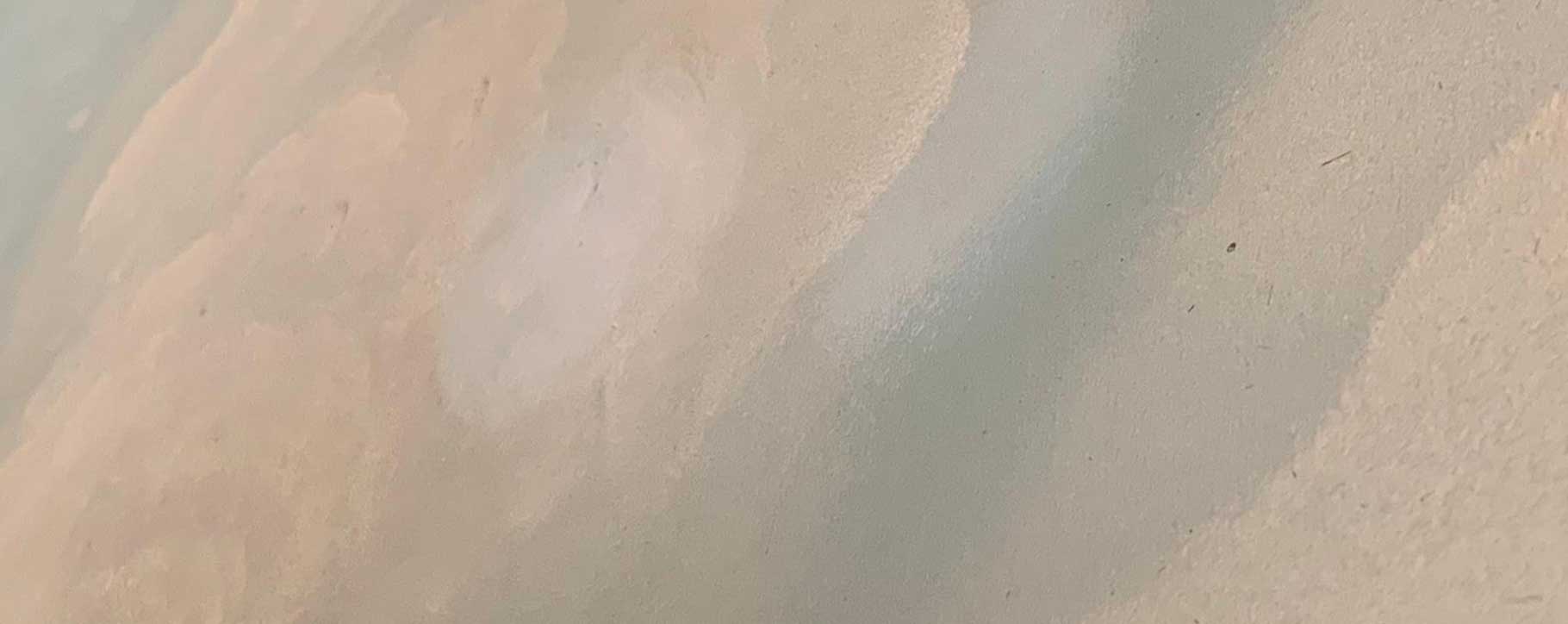
Over the course of several days, even though with adverse weather outside, our conservators Martha and Fiona were able to visit the room to carry out full conservation treatment on the 19th-century mural. Both conservators have previous professional experience with mural conservation, working on both historic artworks and Banksy pieces which often require a wide range of unusual and challenging restoration needs.
Using appropriate scaffolding for the project to reach the artwork with a steady approach, the pair worked upon the areas of cracking and flaking paint. Their consolidation treatment re-adhered the paint to the plaster without any movement of the original artwork. A small injection of conservation adhesive was syringed into the gaps beneath the paint layer, this ensures that it is no longer at risk of falling away. The ceiling was sensitively cleaned of any areas of discolouration, fly spots, plaster salts or mould, including the pale blanched veil which had occurred due to damp conditions.
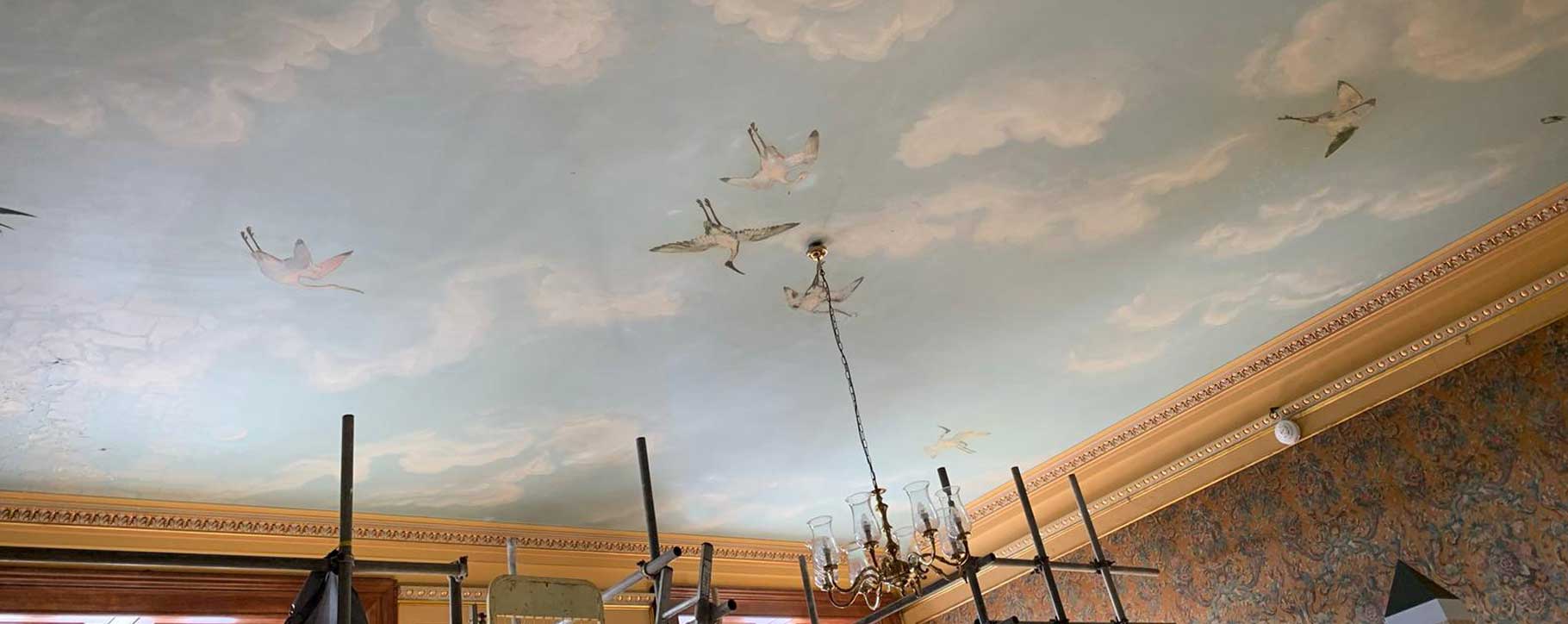
Any areas of missing paint were gently filled in, to return an even surface to the ceiling. The colour was reapplied with conservation-grade pigments. These pigments are importantly used instead of oil paints, as they will age at the same rate as the rest of the work, can be easily removed if required in the future, and will not be confused for the original artwork. Our conservators have a background in fine art and are able to use these skills to seamlessly match the colours and details to the original painting.
The end result of the restoration will allow the Oriel Room to be returned to its former glory, bringing back the bright and natural scene which can now bring wonder to future generations. It will also provide artistic and historic integrity for the Grade I listed property, allowing for a clear and preserved insight into the ideas and styles of the Victorian age.
How to act when faced with a damaged ceiling painting
- Act promptly
- Contact our team as soon as possible
- Find the cause of the damage and halt the issue (such as a leak or infestation)
- If possible, gather old photographs of the artwork to give an idea of what the piece looked like prior to the damage
- If the damage is caused by a leak, ensure the artwork is dried out naturally and not with heaters or industrial drying units
To prevent the acceleration of decay, it is recommended that swift and rapid action is taken at the first signs of any problem. Whilst this is sometimes not so easy, as is the case with the Oriel Room mural, having a plan of action is always recommended, especially in historically important buildings or those that hold precious items. The faster conservation treatment can take place, the more of the original artwork will be saved, less intervention will be required, and the lower the costs will be for restoration.
Our team is on call for any of your concerns or queries surrounding this type of conservation treatment, so please do not hesitate to get in touch if you have any reservations about the safety and security of murals, historic wallpaper, or any other type of interior artwork which may have faced accidental or household damage. This is also the case for artworks that may be in need of swift intervention due to signs of natural or environmental deterioration (a disturbed paint layer, discolouration, loss of detail, etc.) as this will also allow them to be safely preserved before more drastic issues occur in the future.
If you have artwork in need of restoration or conservation treatment, please get in touch with our team today by emailing [email protected] or calling 0207 112 7576.

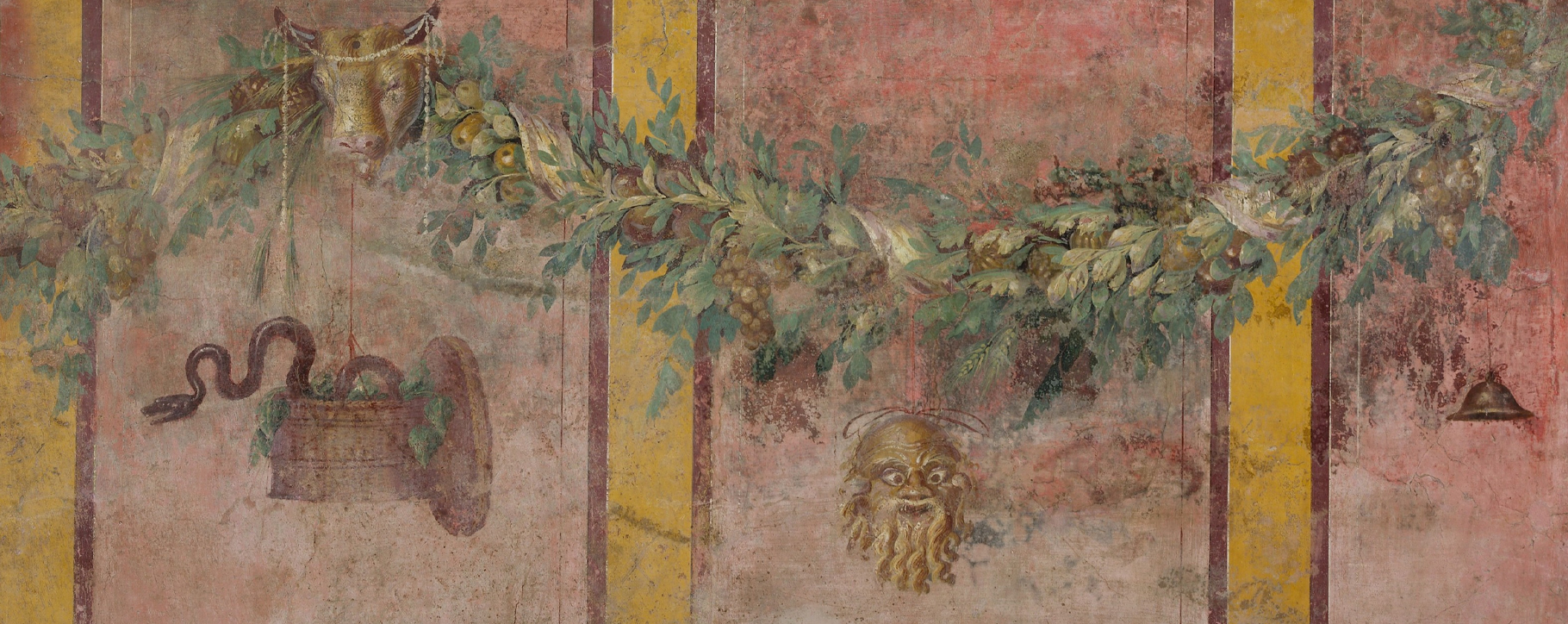 Above: a detail from a Roman wall fresco, 50-40 BCE
Above: a detail from a Roman wall fresco, 50-40 BCE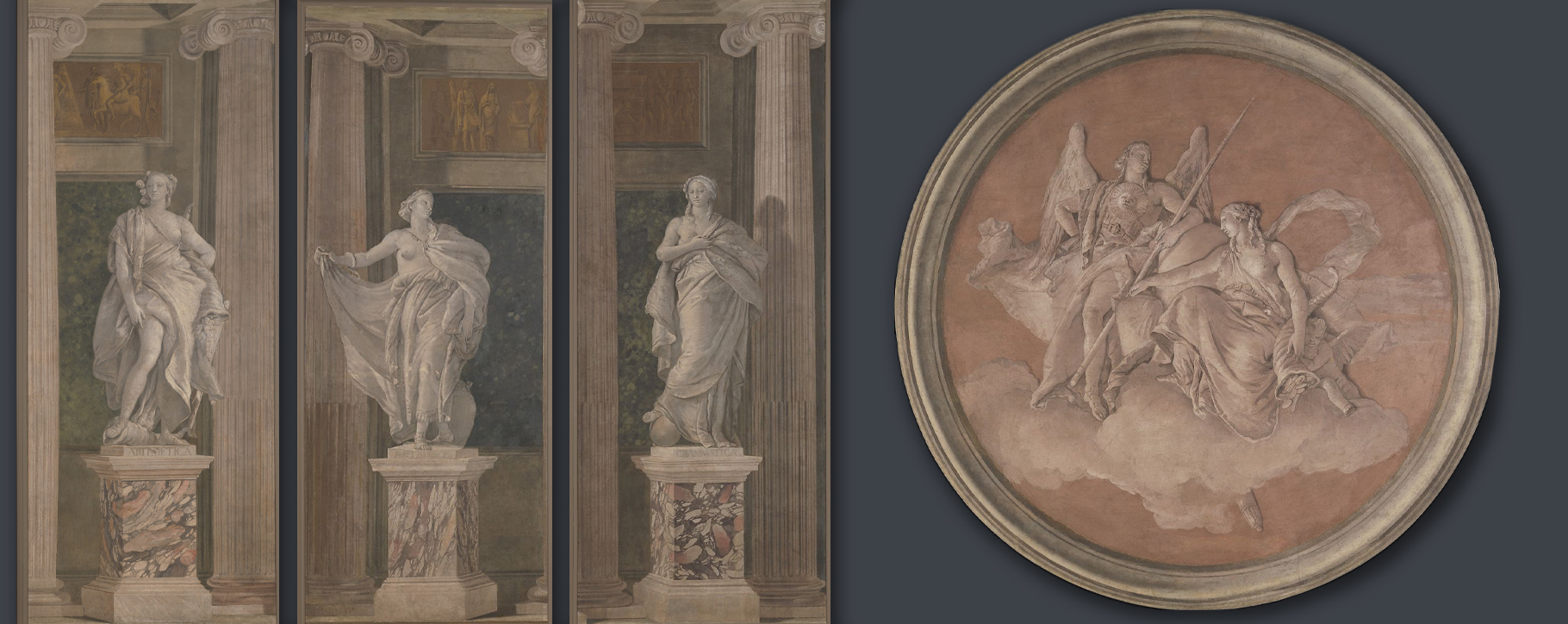 Above: a selection of fresco paintings by Giovanni Battista Tiepolo and Girolamo Mengozzi, 18th century
Above: a selection of fresco paintings by Giovanni Battista Tiepolo and Girolamo Mengozzi, 18th century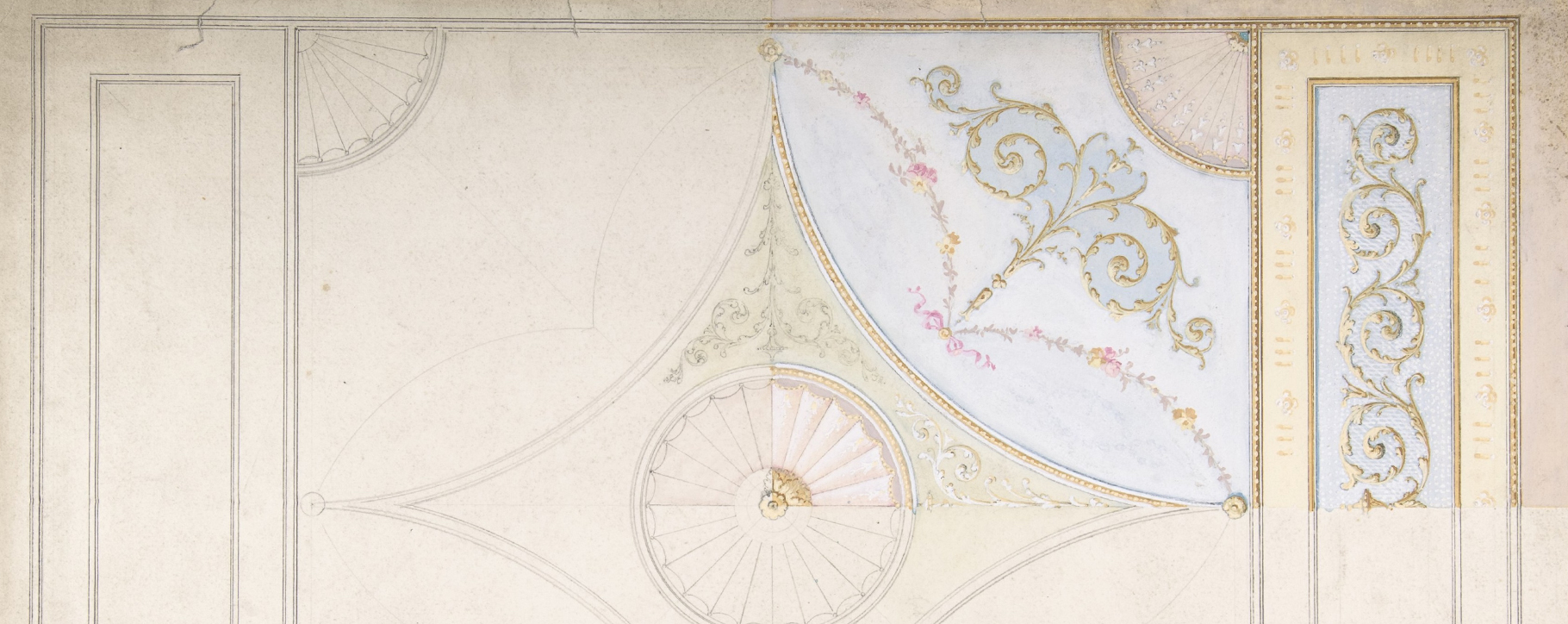 Above: a late 19th century ceiling design
Above: a late 19th century ceiling design




